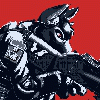
S-AP-T5-R 5026A is the Expedition classification for a Parasitoid species common on several of the red pyramid worlds.
The classification breaks up as follows:
S: Special Category. This is an unusual type of Lifeform. The First number of the code designates what the specific type is.
AP: Alien Parasite. This is a new form of non-indigenous parasite. This means usually that no treatment is yet available for infections, and that the way the parasite operates is also not fully clear. In the case of 5026A, the former is true, while the latter is not.
T5: Threat Level. The threat indicators range from 0 to 5. 0 is a lifeform that´s either capable of communication and reason, or one that is completely harmless. 5 is a lifeform that could endanger ones own species, and the only course of action to take is to make this lifeform go extinct, no matter the cost.
R: Rare. The last digit indicates rarity. Rare lifeforms are very uncommon: they are only found in very restricted areas of the galaxy, and even there only a certain range of locations harbours them.
The code number consists of a one or two digit ID, and a four digit catalogue number. In this case 5026A. The 5 indicates that it is a lifeform that can survive exposure to a vacuum, for prolongued periods. Wether a dangerous species such as 5026A is T4 or T5 is usually decided by wether it can survive long times floating in deep space.
The catalogue number is just what it says it is.
S-AP-TS-R 5026A is a parasite, as said before. It can feed off a variety of hosts: as long as a certain set of chemical-biological compounds is found in liquid form inside a living body, it can make use of it as a host. 5026A grows to a length of about 35 centimeters, but its larvae are only about a quarter millimetre in length. 5026A find weak spots in the potential hosts skin, such as pores, or thin skin surfaces such as inside the throat, nose cavity, the inside of the ear drums or any other bodily opening they can reach.
They then bury into this spot, and begin consuming surrounding flesh. The first symptoms of infection present themselves around this time in the shape of skin irritation and rashes.
After about a day and a half, the larvae have grown to two millimetres of length, and begin pushing their feeding appendage into their hosts body. This appendage is flexible, and is usually inserted into blood vessels or similar systems. The tip of the appendage has hooks, which are used to lodge it inside the hosts body. It also secrets a substance that, in most species common inside the red pyramid area, causes the infected location to become numb. Itching seizes, while the rashes remain present.
5026A will continue to grow: after about three days it will have grown to sufficient size to develop the poison capsule inside the tip of its feeding appendage. The capsule contains neural inhibitors, which cause the host to drop into a lethargic state, preventing him from attempting to pull out the parasite. If 5026A is attempted to be pulled out by a third party, it will empty its stomach contents trough the feeding appendage: this cocktail usually leads to immediate death of the host.
After about a week, 5026A has grown to 10 - 15 centimeters in length, and will begin to produce offspring. Its abdomen will swell, as it converts all energy it takes in trough the now disabled host into producing larvae. It will take another week until the creature reaches full size. The host will usually be dead or terminally ill at this point. 5026A´s larvae will then force their way out of the breeding blister and into their parents stomach, trough the feeding appendage into the hosts body, where they will remain until the body is fed upon by another animal. The parent will be destroyed during this process, and will fall off the host after the migration of its young is complete.
The classification breaks up as follows:
S: Special Category. This is an unusual type of Lifeform. The First number of the code designates what the specific type is.
AP: Alien Parasite. This is a new form of non-indigenous parasite. This means usually that no treatment is yet available for infections, and that the way the parasite operates is also not fully clear. In the case of 5026A, the former is true, while the latter is not.
T5: Threat Level. The threat indicators range from 0 to 5. 0 is a lifeform that´s either capable of communication and reason, or one that is completely harmless. 5 is a lifeform that could endanger ones own species, and the only course of action to take is to make this lifeform go extinct, no matter the cost.
R: Rare. The last digit indicates rarity. Rare lifeforms are very uncommon: they are only found in very restricted areas of the galaxy, and even there only a certain range of locations harbours them.
The code number consists of a one or two digit ID, and a four digit catalogue number. In this case 5026A. The 5 indicates that it is a lifeform that can survive exposure to a vacuum, for prolongued periods. Wether a dangerous species such as 5026A is T4 or T5 is usually decided by wether it can survive long times floating in deep space.
The catalogue number is just what it says it is.
S-AP-TS-R 5026A is a parasite, as said before. It can feed off a variety of hosts: as long as a certain set of chemical-biological compounds is found in liquid form inside a living body, it can make use of it as a host. 5026A grows to a length of about 35 centimeters, but its larvae are only about a quarter millimetre in length. 5026A find weak spots in the potential hosts skin, such as pores, or thin skin surfaces such as inside the throat, nose cavity, the inside of the ear drums or any other bodily opening they can reach.
They then bury into this spot, and begin consuming surrounding flesh. The first symptoms of infection present themselves around this time in the shape of skin irritation and rashes.
After about a day and a half, the larvae have grown to two millimetres of length, and begin pushing their feeding appendage into their hosts body. This appendage is flexible, and is usually inserted into blood vessels or similar systems. The tip of the appendage has hooks, which are used to lodge it inside the hosts body. It also secrets a substance that, in most species common inside the red pyramid area, causes the infected location to become numb. Itching seizes, while the rashes remain present.
5026A will continue to grow: after about three days it will have grown to sufficient size to develop the poison capsule inside the tip of its feeding appendage. The capsule contains neural inhibitors, which cause the host to drop into a lethargic state, preventing him from attempting to pull out the parasite. If 5026A is attempted to be pulled out by a third party, it will empty its stomach contents trough the feeding appendage: this cocktail usually leads to immediate death of the host.
After about a week, 5026A has grown to 10 - 15 centimeters in length, and will begin to produce offspring. Its abdomen will swell, as it converts all energy it takes in trough the now disabled host into producing larvae. It will take another week until the creature reaches full size. The host will usually be dead or terminally ill at this point. 5026A´s larvae will then force their way out of the breeding blister and into their parents stomach, trough the feeding appendage into the hosts body, where they will remain until the body is fed upon by another animal. The parent will be destroyed during this process, and will fall off the host after the migration of its young is complete.
Category Artwork (Digital) / Fantasy
Species Unspecified / Any
Size 1024 x 768px
File Size 78 kB

 FA+
FA+










Comments